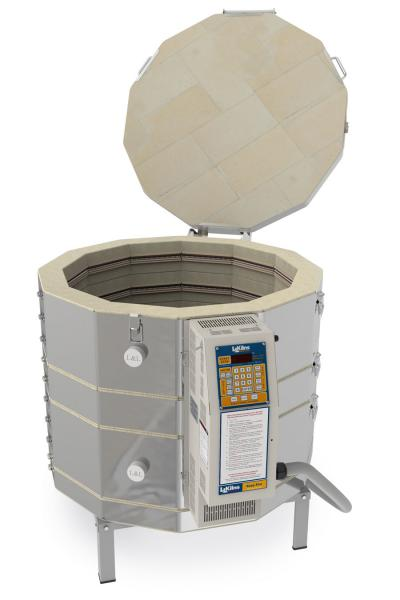 |
| Honey jars on the left are base glazed with a white |
It has a busy Spring, even though Winter seemed to hang on for way too long. I received and order for honey jars and mugs from
Savannah Bee based in Savannah, GA after Christmas. This company a large honey company that makes many products using honey as a base and also sells a wide variety of honeys.
I started into production of 50 of each type of form in late March as soon as some warmer weather started up. At the same time this is the time of year for Communion sets purchased by the
Order of St. Luke for graduation awards. Most of these had already been completed in the Fall, but there were several that had need of glaze firing and some that needed to be thrown.
The days of glazing after bisquefires started on the 23rd of April, and went until May 3rd to complete the order for Savannah. We packed up and were on the road that Friday, to return on Sunday. Great day on Saturday spent with my nephew. We had breakfast, and then went to one the offices of Savannah Bee to drop off the pottery, and do a little shopping in their store full of honey based products. The rest of the weekend was uneventful, but great weather, great company and food. Savannah is a foodie haven, and a walking city with lots to see.
 |
| Bisqued mugs, patens pitcher and bowl |
 |
| Mugs stored in kiln until bottoms are ground |
The mugs on the right are ready for glazing after bisque firing. I use a base liner white, with 3 over sprayed glazes; spraying from different directions with the first two then spraying over all with a Rutile Green.
The mugs here in the kiln are waiting the grinding of the bottoms, and final quality checks.
This year I have had to make a change in some of my work habits and ethics. I used to believe my pulled handles were really nice, and that I would never do another type of handle. However, age, and the visitation or arthritis in my right thumb has made me start using extruded handles for my mugs. These handles are made with a commercial die that I modified greatly with my Dremel tool and a grinding tip.
 |
| Mugs with extruded handles |
I believe if you compare the mugs on the left to my earlier posts that you will see very little difference in the handle shape. These are of the extruded type, and the older posts are of the pulled handle type.
I also
believe the extruded handles to be somewhat stronger than the pulled ones.

Honey jars were part of the reason for the order from
Savannah Bee as I had sent a few down to Savannah with some relatives to be delivered as
proof of concept to the company.
The jar lids do not have the usual notch in the lid, as I wanted something that was more bug safe than the jars with the traditional honey stick in the jar with a notch in the lid. My lids are thrown with a hollow handle to be lighter, but with a thrown spoon with a hole in the side opposite the spoon notch to drizzle the honey onto biscuits or other food. I have been playing around with lots of different forms for this, and find this closed form to work quite well as the spoon.
You will notice in the pictures that the stem has a hole opposite of the spoon opening that allows one to tip the spoon and drizzle the honey onto the food.
The Communion Sets are given as presentation sets to new inductees into the ministry at various seminary schools across the country. This years sets have been stunning, and I am pleased to be finally sending out the last of the orders as the last load is cooling.
 |
Patens are made larger and a little deeper to handle a
bread loaf. |
 |
| Chalice and Paten |
 |
Close-up of chalice with combination of New white base,
Cream rust, and Variegated blue, with Rutile Green over spray. |
 |
| Bowl and Pitcher |
Occasionally there is a need for a different type of award, and this year there was a request for a pitcher and bowl for a Deacon.
So it is official, as Pic Works pottery mugs and honey jars should become available on the shelves of Savannah Bee stores in May.
















































